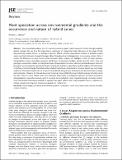Files in this item
Plant speciation across environmental gradients and the occurrence and nature of hybrid zones
Item metadata
| dc.contributor.author | Abbott, Richard John | |
| dc.date.accessioned | 2018-07-18T23:35:00Z | |
| dc.date.available | 2018-07-18T23:35:00Z | |
| dc.date.issued | 2017-07 | |
| dc.identifier | 250560368 | |
| dc.identifier | 0be028ca-fd8e-4e2a-b41f-ec8daafff3c9 | |
| dc.identifier | 85025102612 | |
| dc.identifier | 000406115000002 | |
| dc.identifier.citation | Abbott , R J 2017 , ' Plant speciation across environmental gradients and the occurrence and nature of hybrid zones ' , Journal of Systematics and Evolution , vol. 55 , no. 4 , pp. 238-258 . https://doi.org/10.1111/jse.12267 | en |
| dc.identifier.issn | 1674-4918 | |
| dc.identifier.uri | https://hdl.handle.net/10023/15556 | |
| dc.description | Funding: Natural Environment Research Council (Grant: NE/D014166/1) | en |
| dc.description.abstract | Environmental gradients are very common and many plant species respond to them through adaptive genetic change. This can be a first step along a continuum of change that leads ultimately to the origin of fully reproductively isolated forms, i.e., ‘biological species’. Before complete reproductive isolation is achieved, hybrid zones may form between divergent lineages either through primary intergradation or secondary contact. Here, I review the literature on plant hybrid zones between native species and highlight: mode of origin (primaryintergradation versus secondary contact); distribution among plant families, genera and life form; type and genotypic composition related to strength and type of reproductive isolation between parental lineages; nature of prezygotic and postzygotic reproductive barriers; level and direction of gene flow; and the stability of hybrid zones in the face of climate change. The total number of plant hybrid zones detected in a literature search was surprisingly small (137). This was the case even for areas of the world with a long history of research into plant evolution, ecology and systematics. Reasons for this are discussed, including the possibility that plant hybrid zones are naturally rare inthe wild. Only for a few hybrid zones have attempts been made to distinguish between formation by primary intergradation or secondary contact, and it is assumed that most hybrid zones originate through secondary contact.From the limited information available, it appears that plant hybrid zones may frequently move in response to climate change, but long-term studies are required to confirm this. | |
| dc.format.extent | 584603 | |
| dc.language.iso | eng | |
| dc.relation.ispartof | Journal of Systematics and Evolution | en |
| dc.subject | Climate Change | en |
| dc.subject | Disturbance | en |
| dc.subject | Environmental gradients | en |
| dc.subject | Hybridization | en |
| dc.subject | Hybrid zones | en |
| dc.subject | Reproductive isolation | en |
| dc.subject | Secondary contact | en |
| dc.subject | Speciation | en |
| dc.subject | GE Environmental Sciences | en |
| dc.subject | QH301 Biology | en |
| dc.subject | SDG 13 - Climate Action | en |
| dc.subject.lcc | GE | en |
| dc.subject.lcc | QH301 | en |
| dc.title | Plant speciation across environmental gradients and the occurrence and nature of hybrid zones | en |
| dc.type | Journal item | en |
| dc.contributor.sponsor | NERC | en |
| dc.contributor.institution | University of St Andrews. School of Biology | en |
| dc.contributor.institution | University of St Andrews. Scottish Oceans Institute | en |
| dc.contributor.institution | University of St Andrews. St Andrews Sustainability Institute | en |
| dc.identifier.doi | https://doi.org/10.1111/jse.12267 | |
| dc.description.status | Peer reviewed | en |
| dc.date.embargoedUntil | 2018-07-19 | |
| dc.identifier.grantnumber | NE/D014166/1 | en |
This item appears in the following Collection(s)
Items in the St Andrews Research Repository are protected by copyright, with all rights reserved, unless otherwise indicated.

